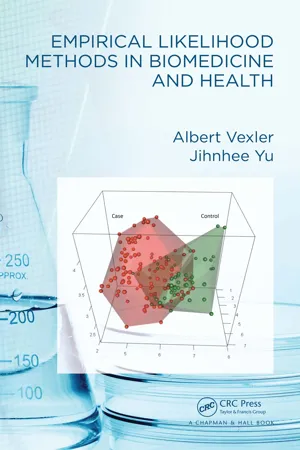
- 300 pages
- English
- ePUB (mobile friendly)
- Available on iOS & Android
Empirical Likelihood Methods in Biomedicine and Health
About This Book
Empirical Likelihood Methods in Biomedicine and Health provides a compendium of nonparametric likelihood statistical techniques in the perspective of health research applications. It includes detailed descriptions of the theoretical underpinnings of recently developed empirical likelihood-based methods. The emphasis throughout is on the application of the methods to the health sciences, with worked examples using real data.
- Provides a systematic overview of novel empirical likelihood techniques.
- Presents a good balance of theory, methods, and applications.
- Features detailed worked examples to illustrate the application of the methods.
- Includes R code for implementation.
The book material is attractive and easily understandable to scientists who are new to the research area and may attract statisticians interested in learning more about advanced nonparametric topics including various modern empirical likelihood methods. The book can be used by graduate students majoring in biostatistics, or in a related field, particularly for those who are interested in nonparametric methods with direct applications in Biomedicine.
Frequently asked questions
Information
Table of contents
- Cover
- Half Title
- Title Page
- Copyright Page
- Dedication
- Table of Contents
- Preface
- Authors
- 1. Preliminaries
- 2. Basic Ingredients of the Empirical Likelihood
- 3. Empirical Likelihood in Light of Nonparametric Bayesian Inference
- 4. Empirical Likelihood for Probability Weighted Moments
- 5. Two-Group Comparison and Combining Likelihoods Based on Incomplete Data
- 6. Quantile Comparisons
- 7. Empirical Likelihood for a U-Statistic Constraint
- 8. Empirical Likelihood Application to Receiver Operating Characteristic Curve Analysis
- 9. Various Topics
- References
- Name Index
- Subject Index